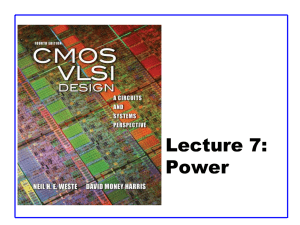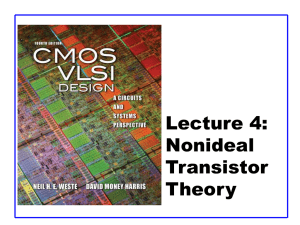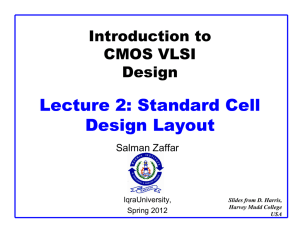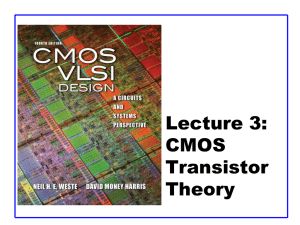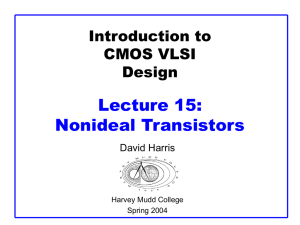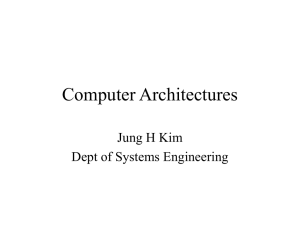Nonideal Transistor Theory
advertisement
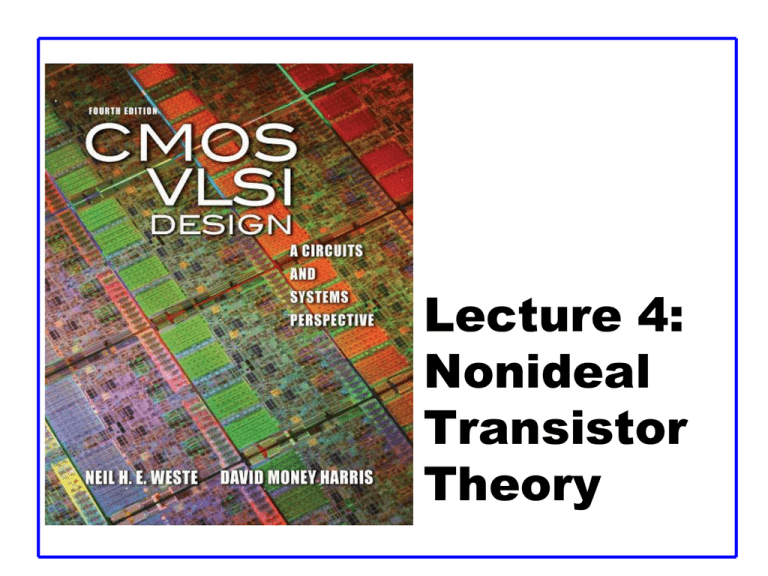
Lecture 4: Nonideal Transistor Theory Outline Nonideal Transistor Behavior – High Field Effects • Mobility Degradation • Velocity Saturation – Channel Length Modulation – Threshold Voltage Effects • Body Effect • Drain-Induced Barrier Lowering • Short Channel Effect – Leakage • Subthreshold Leakage • Gate Leakage • Junction Leakage Process and Environmental Variations 4: Nonideal Transistor Theory CMOS VLSI Design 4th Ed. 2 Ideal Transistor I-V Shockley long-channel transistor models I ds 0 V V V ds V gs ds t 2 2 V gs 4: Nonideal Transistor Theory Vt 2 V gs V t cutoff V ds V dsat linear V ds V dsat saturatio n CMOS VLSI Design 4th Ed. 3 Ideal vs. Simulated nMOS I-V Plot 65 nm IBM process, VDD = 1.0 V Ids (A) Simulated Vgs = 1.0 Ideal 1200 Velocity saturation & Mobility degradation: Ion lower than ideal model predicts 1000 Ion = 747 mA @ Channel length modulation: V = V = V DD ds gs Saturation current increases with Vds Vgs = 1.0 800 Vgs = 0.8 600 Velocity saturation & Mobility degradation: Saturation current increases less than quadratically with Vgs 400 Vgs = 0.8 Vgs = 0.6 200 Vgs = 0.6 Vgs = 0.4 0 Vds 0 0.2 4: Nonideal Transistor Theory 0.4 0.6 CMOS VLSI Design 4th Ed. 0.8 1 4 ON and OFF Current Ion = Ids @ Vgs = Vds = VDD – Saturation Ids (A) 1000 Ion = 747 mA @ Vgs = Vds = VDD 800 Vgs = 1.0 600 Vgs = 0.8 400 Vgs = 0.6 200 Vgs = 0.4 0 Vds 0 0.2 0.4 0.6 0.8 1 Ioff = Ids @ Vgs = 0, Vds = VDD – Cutoff 4: Nonideal Transistor Theory CMOS VLSI Design 4th Ed. 5 Electric Fields Effects Vertical electric field: Evert = Vgs / tox – Attracts carriers into channel – Long channel: Qchannel Evert Lateral electric field: Elat = Vds / L – Accelerates carriers from drain to source – Long channel: v = Elat 4: Nonideal Transistor Theory CMOS VLSI Design 4th Ed. 6 Coffee Cart Analogy Tired student runs from VLSI lab to coffee cart Freshmen are pouring out of the physics lecture hall Vds is how long you have been up – Your velocity = fatigue × mobility Vgs is a wind blowing you against the glass (SiO2) wall At high Vgs, you are buffeted against the wall – Mobility degradation At high Vds, you scatter off freshmen, fall down, get up – Velocity saturation • Don’t confuse this with the saturation region 4: Nonideal Transistor Theory CMOS VLSI Design 4th Ed. 7 Mobility Degradation High Evert effectively reduces mobility – Collisions with oxide interface 4: Nonideal Transistor Theory CMOS VLSI Design 4th Ed. 8 Velocity Saturation At high Elat, carrier velocity rolls off – Carriers scatter off atoms in silicon lattice – Velocity reaches vsat • Electrons: 107 cm/s • Holes: 8 x 106 cm/s – Better model 4: Nonideal Transistor Theory CMOS VLSI Design 4th Ed. 9 Vel Sat I-V Effects Ideal transistor ON current increases with VDD2 I ds C ox W V gs V t L 2 2 2 V gs Vt 2 Velocity-saturated ON current increases with VDD I ds C oxW V gs V t v m ax Real transistors are partially velocity saturated – Approximate with a-power law model – Ids VDDa – 1 < a < 2 determined empirically (≈ 1.3 for 65 nm) 4: Nonideal Transistor Theory CMOS VLSI Design 4th Ed. 10 a-Power Model I ds 0 V I dsat ds V dsat I dsat V gs V t cutoff I dsat Pc V ds V dsat linear V ds V dsat saturation 4: Nonideal Transistor Theory CMOS VLSI Design 4th Ed. 2 V gs Vt V dsat Pv V gs V t a a /2 11 Channel Length Modulation Reverse-biased p-n junctions form a depletion region – Region between n and p with no carriers – Width of depletion Ld region grows with reverse bias V V GND Source Gate Drain – Leff = L – Ld Depletion Region Width: L Shorter Leff gives more current – Ids increases with Vds n n L + + L – Even in saturation p GND bulk Si DD DD d eff 4: Nonideal Transistor Theory CMOS VLSI Design 4th Ed. 12 Chan Length Mod I-V I ds 2 V gs Vt 2 1 l V ds l = channel length modulation coefficient – not feature size – Empirically fit to I-V characteristics 4: Nonideal Transistor Theory CMOS VLSI Design 4th Ed. 13 Threshold Voltage Effects Vt is Vgs for which the channel starts to invert Ideal models assumed Vt is constant Really depends (weakly) on almost everything else: – Body voltage: Body Effect – Drain voltage: Drain-Induced Barrier Lowering – Channel length: Short Channel Effect 4: Nonideal Transistor Theory CMOS VLSI Design 4th Ed. 14 Body Effect Body is a fourth transistor terminal Vsb affects the charge required to invert the channel – Increasing Vs or decreasing Vb increases Vt Vt Vt 0 g f s V sb f s fs = surface potential at threshold f s 2 v T ln NA ni – Depends on doping level NA – And intrinsic carrier concentration ni g = body effect coefficient g t ox ox 2 q si N A 4: Nonideal Transistor Theory 2 q si N A C ox CMOS VLSI Design 4th Ed. 15 Body Effect Cont. For small source-to-body voltage, treat as linear 4: Nonideal Transistor Theory CMOS VLSI Design 4th Ed. 16 DIBL Electric field from drain affects channel More pronounced in small transistors where the drain is closer to the channel Drain-Induced Barrier Lowering VVV – Drain voltage also affect Vt ttds V t V t V ds High drain voltage causes current to increase. 4: Nonideal Transistor Theory CMOS VLSI Design 4th Ed. 17 Short Channel Effect In small transistors, source/drain depletion regions extend into the channel – Impacts the amount of charge required to invert the channel – And thus makes Vt a function of channel length Short channel effect: Vt increases with L – Some processes exhibit a reverse short channel effect in which Vt decreases with L 4: Nonideal Transistor Theory CMOS VLSI Design 4th Ed. 18 Leakage What about current in cutoff? Simulated results What differs? – Current doesn’t go to 0 in cutoff 4: Nonideal Transistor Theory CMOS VLSI Design 4th Ed. 19 Leakage Sources Subthreshold conduction – Transistors can’t abruptly turn ON or OFF – Dominant source in contemporary transistors Gate leakage – Tunneling through ultrathin gate dielectric Junction leakage – Reverse-biased PN junction diode current 4: Nonideal Transistor Theory CMOS VLSI Design 4th Ed. 20 Subthreshold Leakage Subthreshold leakage exponential with Vgs V gs V t 0 V ds k g V sb I ds I ds 0 e nvT V ds v 1 e T n is process dependent – typically 1.3-1.7 Rewrite relative to Ioff on log scale S ≈ 100 mV/decade @ room temperature 4: Nonideal Transistor Theory CMOS VLSI Design 4th Ed. 21 Gate Leakage Carriers tunnel thorough very thin gate oxides Exponentially sensitive to tox and VDD – A and B are tech constants – Greater for electrons • So nMOS gates leak more Negligible for older processes (tox > 20 Å) Critically important at 65 nm and below (tox ≈ 10.5 Å) From [Song01] 4: Nonideal Transistor Theory CMOS VLSI Design 4th Ed. 22 Junction Leakage Reverse-biased p-n junctions have some leakage – Ordinary diode leakage – Band-to-band tunneling (BTBT) – Gate-induced drain leakage (GIDL) p+ n+ n+ p+ p+ n+ n well p substrate 4: Nonideal Transistor Theory CMOS VLSI Design 4th Ed. 23 Diode Leakage Reverse-biased p-n junctions have some leakage vD T IS e 1 V ID At any significant negative diode voltage, ID = -Is Is depends on doping levels – And area and perimeter of diffusion regions – Typically < 1 fA/m2 (negligible) 4: Nonideal Transistor Theory CMOS VLSI Design 4th Ed. 24 Band-to-Band Tunneling Tunneling across heavily doped p-n junctions – Especially sidewall between drain & channel when halo doping is used to increase Vt Increases junction leakage to significant levels – Xj: sidewall junction depth – Eg: bandgap voltage – A, B: tech constants 4: Nonideal Transistor Theory CMOS VLSI Design 4th Ed. 25 Gate-Induced Drain Leakage Occurs at overlap between gate and drain – Most pronounced when drain is at VDD, gate is at a negative voltage – Thwarts efforts to reduce subthreshold leakage using a negative gate voltage 4: Nonideal Transistor Theory CMOS VLSI Design 4th Ed. 26 Temperature Sensitivity Increasing temperature – Reduces mobility – Reduces Vt ION decreases with temperature IOFF increases with temperature I ds increasing temperature Vgs 4: Nonideal Transistor Theory CMOS VLSI Design 4th Ed. 27 So What? So what if transistors are not ideal? – They still behave like switches. But these effects matter for… – Supply voltage choice – Logical effort – Quiescent power consumption – Pass transistors – Temperature of operation 4: Nonideal Transistor Theory CMOS VLSI Design 4th Ed. 28 Parameter Variation fast Transistors have uncertainty in parameters – Process: Leff, Vt, tox of nMOS and pMOS – Vary around typical (T) values Fast (F) – Leff: short – Vt: low – tox: thin Slow (S): opposite nMOS Not all parameters are independent for nMOS and pMOS FF pMOS SF TT slow slow 4: Nonideal Transistor Theory CMOS VLSI Design 4th Ed. FS SS fast 29 Environmental Variation VDD and T also vary in time and space Fast: – VDD: high – T: low Corner Voltage Temperature F 1.98 0C T 1.8 70 C S 1.62 125 C 4: Nonideal Transistor Theory CMOS VLSI Design 4th Ed. 30 Process Corners Process corners describe worst case variations – If a design works in all corners, it will probably work for any variation. Describe corner with four letters (T, F, S) – nMOS speed – pMOS speed – Voltage – Temperature 4: Nonideal Transistor Theory CMOS VLSI Design 4th Ed. 31 Important Corners Some critical simulation corners include Purpose nMOS pMOS VDD Temp Cycle time S S S S Power F F F F Subthreshold leakage F F F S 4: Nonideal Transistor Theory CMOS VLSI Design 4th Ed. 32
